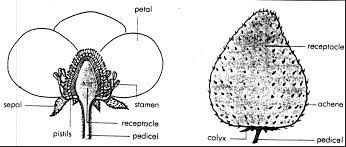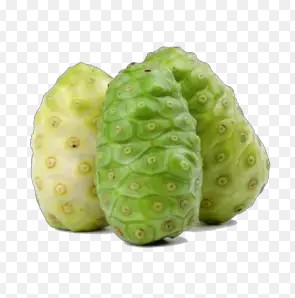Fruits play an essential role in both the natural world and human diets, offering a vast range of nutritional benefits and ecological functions. The way fruits are classified can seem complex, with terms like “aggregate” and “multiple” often causing confusion. This distinction is not just academic; it has practical implications for everything from gardening to nutrition.
Aggregate and multiple fruits differ primarily in their formation. Aggregate fruits develop from multiple ovaries of a single flower, leading to a fruit that seems like a cluster of smaller fruits merged together. In contrast, multiple fruits form from the ovaries of several flowers growing closely together, which fuse over time to create a single, larger fruit entity.
Understanding these categories not only enriches our appreciation for the diversity of plant life but also informs our choices in cultivation, consumption, and conservation. As we explore the intricacies of aggregate and multiple fruits, we uncover the fascinating processes behind their development and the reasons behind their distinct characteristics.

Fruit Basics
What is Fruit?
Definition and Role in Nature
A fruit is the mature ovary of a flower, typically containing seeds. Fruits serve a dual role in nature: they are crucial for the reproductive cycle of plants, facilitating the dispersion of seeds, and they provide nutrition to various forms of wildlife, including humans. From sweet, juicy apples to tart cranberries, fruits are diverse in flavor, color, and texture, reflecting their adaptation to different environmental conditions and seed dispersal strategies.
Fruit Types Overview
Fruits can be broadly categorized into three types: simple, aggregate, and multiple. Each type is determined by the structure of the ovary in the flower and the method of development. Simple fruits develop from a single ovary, aggregate fruits from multiple ovaries of one flower, and multiple fruits from the ovaries of many flowers merging together.
Fruit Classification
Simple, Aggregate, and Multiple Fruits
The classification into simple, aggregate, and multiple fruits is based on the origin of the fruit structure. Simple fruits are further divided into fleshy or dry, depending on their texture at maturity. Aggregate fruits are unique because they form from a single flower with multiple ovaries. Multiple fruits, on the other hand, result from a cluster of flowers, each producing a fruit, but merging to form a single mass.
Basis for Classification
The key criterion for classifying fruits into these categories is the flower’s structure and how the fruits develop from it. This classification helps botanists and horticulturists understand and predict the behavior of different plants in cultivation, their ecological roles, and their potential uses in diets and industry.
Aggregate Fruits Explained
Definition
An aggregate fruit is one that develops from the multiple ovaries of a single flower. Unlike simple fruits that originate from one ovary, aggregate fruits are composed of multiple smaller fruits, known as fruitlets, each stemming from its own ovary.
Characteristics of Aggregate Fruits
Aggregate fruits often have a distinct appearance, with fruitlets visibly clustered together on a single structure. This formation process makes them fascinating both botanically and culinarily.
Formation Process
The formation of aggregate fruits involves several steps:
- A single flower with multiple ovaries is pollinated.
- Each ovary begins to develop into a small fruit.
- As they mature, these small fruits remain connected, forming the aggregate fruit.
Examples
Common Aggregate Fruits
Examples include strawberries, raspberries, and blackberries. Each of these fruits displays the typical characteristics of aggregate fruits, with multiple fruitlets contributing to the whole.
Unique Features
Strawberries are unique because what we commonly consider to be the fruit is actually the swollen receptacle of the flower, while the tiny seeds on its surface are the actual fruitlets. Raspberries and blackberries, in contrast, have fruitlets that form around a core, which is left behind when the fruit is picked.
Significance
Ecological and Nutritional Importance
Aggregate fruits play a significant role in ecosystems, offering food sources for wildlife and facilitating seed dispersion. Nutritionally, they are often rich in vitamins, fibers, and antioxidants, making them beneficial in human diets as well.
Multiple Fruits Explained
Definition
Multiple fruits form from the ovaries of multiple flowers that are closely packed together. As the flowers’ ovaries swell and mature, they merge into a single, larger fruit mass.
Characteristics of Multiple Fruits
These fruits are characterized by their composite nature, with the entire structure representing a collection of merged simple fruits.
Formation Process
The formation involves the following steps:
- A cluster of flowers grows closely together.
- Each flower’s ovary starts to develop into a fruit after pollination.
- These individual fruits grow and merge into one larger fruit.
Examples
Common Multiple Fruits
Pineapples and figs are prime examples. A pineapple is formed from a cluster of flowers whose fruits merge into the large, spiky fruit we recognize. Figs are slightly different, with the flowers and fruits developing inside a hollowed-out stem.
Unique Features
The pineapple’s rough, scaly exterior hides the merged fruitlets, each corresponding to an eye on the fruit’s surface. Figs have an internal structure where the flowers pollinate and grow within, making them unique among fruits.
Significance
Ecological and Nutritional Importance
Multiple fruits also play critical roles in their ecosystems, particularly in supporting complex pollination mechanisms. Nutritional benefits include a rich provision of vitamins, minerals, and fiber, contributing significantly to dietary diversity and health.

Key Differences
Formation Process
Comparison of Development Processes
The formation process of aggregate and multiple fruits is a key difference between them. Aggregate fruits develop from a single flower that has multiple ovaries, each becoming a separate fruitlet in the final fruit. On the other hand, multiple fruits result from the ovaries of several flowers, which are close together, merging into a single fruit. This fundamental difference in origin has implications for the fruit’s structure, appearance, and even nutritional content.
Botanical Structure
Structural Differences
The botanical structure of these fruits also highlights significant differences. Aggregate fruits are essentially a collection of fruitlets that are attached to a common base, which itself was part of the single flower. In contrast, multiple fruits have a more complex structure since they originate from a cluster of flowers. This results in a fruit that might look singular from the outside but is internally complex, containing the remnants of multiple ovaries from different flowers.
Examples in Nature
Distinguishing Examples
In nature, these differences are exemplified by fruits like strawberries and raspberries (aggregate) versus pineapples and figs (multiple). Strawberries have tiny seeds on their surface, each representing a single ovary from the flower. Pineapples, showcasing multiple fruit characteristics, develop a rough exterior that encapsulates the merged fruits of multiple flowers.
Implications and Importance
Ecological Impact
Role in Ecosystems
The ecological impact of these fruit types varies greatly. Aggregate fruits, with their multiple seeds, can attract a variety of pollinators and seed dispersers, enhancing biodiversity. Multiple fruits, given their often larger size and complexity, can provide substantial nourishment to larger animals, playing a pivotal role in their survival and the propagation of plant species.
Nutritional Value
Differences in Nutritional Benefits
There are also differences in the nutritional value offered by aggregate and multiple fruits. Generally, aggregate fruits are rich in antioxidants, vitamins, and fiber, beneficial for heart health and preventing chronic diseases. Multiple fruits, while also nutritious, may offer different benefits due to their varied composition, including higher energy content and unique vitamins or minerals specific to the species.
Agricultural and Economic Aspects
Impact on Agriculture and Economy
The agricultural and economic aspects of growing aggregate versus multiple fruits are significant. Aggregate fruits, such as berries, are often labor-intensive to harvest but can fetch a high price in markets due to their health benefits and flavor. Multiple fruits, like pineapples, might require more space and time to grow but can be harvested mechanically, leading to different economic scales and market dynamics. Understanding these differences is crucial for farmers and agricultural planners to make informed decisions about crop selection, cultivation practices, and market strategies.
In-Depth Exploration
To understand the distinction between aggregate and multiple fruits fully, one must delve into the nuances of their formation, structure, and role in nature. These differences not only highlight the incredible diversity found within the plant kingdom but also underscore the importance of botanical knowledge in agriculture, nutrition, and ecology.
Formation Process Revisited
The formation of these fruit types involves complex biological processes influenced by the flower’s structure, pollination mechanisms, and genetic factors. The journey from flower to fruit is a fascinating aspect of plant development that reflects evolution’s ingenuity.
Botanical Structure and Its Consequences
The structural differences between aggregate and multiple fruits have far-reaching implications beyond mere appearance. They affect the fruit’s development, its interaction with the ecosystem, and even how it can be used by humans, whether in cuisine, medicine, or industry.
Ecological Dynamics
The ecological roles of these fruits extend beyond simple nutrition. They are integral in the pollination and seed dispersal processes, affecting the distribution and diversity of plant species within ecosystems. The specific characteristics of aggregate and multiple fruits can influence which animals interact with them, how they are dispersed, and ultimately, the survival and spread of the plant species.
Nutritional Insights
From a nutritional standpoint, understanding the differences between these fruits can guide dietary choices and agricultural practices. The varied nutritional profiles of aggregate and multiple fruits underscore the importance of biodiversity in our diets, offering a range of health benefits and culinary possibilities.
Agricultural Implications
For agriculture, the cultivation of aggregate versus multiple fruits involves different strategies, challenges, and benefits. Factors such as climate, soil type, labor requirements, and market demand can influence the decision to grow one type of fruit over the other. Additionally, technological advancements in agriculture can affect how these fruits are produced, harvested, and brought to market, further impacting their economic and nutritional value.

FAQs
What is an aggregate fruit?
An aggregate fruit forms from the merger of several ovaries that were separate in a single flower. Each segment, or “fruitlet,” originates from one ovary, and together, they create the complete fruit. Strawberries, raspberries, and blackberries are classic examples, where each visible seed on their surface represents a separate ovary from the original flower.
How do multiple fruits form?
Multiple fruits result from the fusion of the ovaries of multiple flowers growing in a cluster. As these flowers bloom and mature closely together, their ovaries merge into a singular, larger fruit. Pineapples and figs exemplify this category, showcasing how numerous individual flowers can contribute to a single fruit’s formation.
Why are aggregate and multiple fruits significant?
These fruit types are significant for various reasons, including ecological, nutritional, and agricultural aspects. Ecologically, they support biodiversity by attracting different pollinators. Nutritional diversity is another benefit, as these fruits offer a range of vitamins, minerals, and fibers. Agriculturally, understanding these differences can influence cultivation practices and marketability, impacting economic outcomes for farmers and industries.
Conclusion
The world of fruits is as complex as it is fascinating, with aggregate and multiple fruits representing just a glimpse into this diversity. Through understanding the distinct ways these fruits develop and their implications for ecosystems, nutrition, and agriculture, we can appreciate the intricate relationships between plants and their environments. This knowledge not only enhances our dietary choices but also our efforts in conservation and sustainable farming practices.
The exploration of aggregate and multiple fruits reveals the remarkable adaptability and variety within the plant kingdom. As we continue to study and understand these classifications, we unlock further potential in food science, ecological preservation, and our own dietary habits, ensuring that fruits continue to be a vital part of life on Earth.
